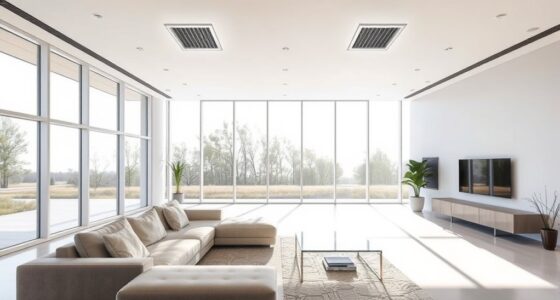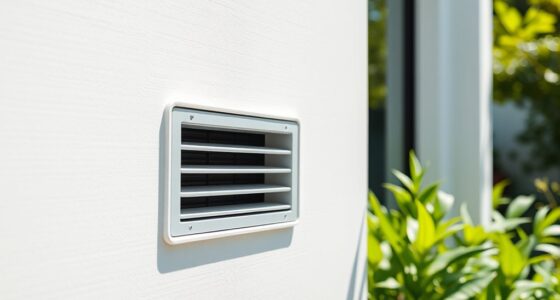To pollen-proof your bedroom during allergy season, start by choosing hypoallergenic bedding and mattress covers that block allergens. Keep windows and doors closed during peak pollen times and use a HEPA filter air purifier to trap airborne particles. Wash your bedding and curtains weekly, and keep clutter to a minimum to reduce dust buildup. Manage pets with regular cleaning and restrict their access, especially to your sleeping area. For more tips to stay allergy-free, there’s plenty more to discover.
Key Takeaways
- Keep windows and doors closed during peak pollen times to prevent outdoor allergens from entering.
- Use HEPA-filter air purifiers in bedrooms to trap airborne pollen and dust mites effectively.
- Cover mattresses and pillows with allergen-proof, dust-mite-proof bedding to block allergen penetration.
- Wash bedding, curtains, and pet bedding weekly in hot water to remove accumulated allergens.
- Limit pet access to bedrooms and regularly groom pets to reduce pet dander and indoor allergens.
Choosing the Right Bedding and Mattress Covers

Choosing the right bedding and mattress covers is essential for reducing allergy symptoms during peak season. Opt for hypoallergenic bedding that’s specially designed to block dust mites, pollen, and other allergens. Look for mattress covers labeled dust-mite-proof or allergen barrier to create a protective barrier around your mattress. These covers help prevent allergens from settling into your mattress and bedding, making it easier to breathe at night. Regularly wash your hypoallergenic bedding in hot water to eliminate accumulated allergens. Avoid using feather or down-filled pillows and comforters, as they can trap dust and pollen. Instead, choose synthetic or hypoallergenic options that are less likely to harbor allergens. Additionally, selecting high-quality projectors with accurate color reproduction can help create a relaxing environment conducive to better sleep. By selecting the right mattress covers and bedding, you’re taking a vital step toward a healthier, allergy-free sleep environment.
Keeping Windows and Doors Closed During Peak Pollen Times

During peak pollen season, keeping your windows and doors closed is one of the most effective ways to prevent outdoor allergens from entering your home. Proper window insulation helps maintain a barrier against pollen, reducing infiltration. By controlling outdoor air, you limit exposure and improve indoor air quality. Use the table below to understand the benefits of indoor control:
| Benefit | Explanation |
|---|---|
| Reduced Pollen Entry | Keeps outdoor allergens outside |
| Improved Comfort | Maintains stable indoor temperature |
| Enhanced Air Quality | Limits airborne pollen and pollutants |
| Energy Efficiency | Less draft reduces heating/cooling costs |
| Better Allergy Management | Less allergen exposure inside |
Keeping windows and doors shut during high pollen times is essential for allergy relief and indoor comfort. Engaging in meditation techniques can also help manage stress associated with allergy symptoms and improve overall well-being.
Using High-Quality Air Purifiers With HEPA Filters
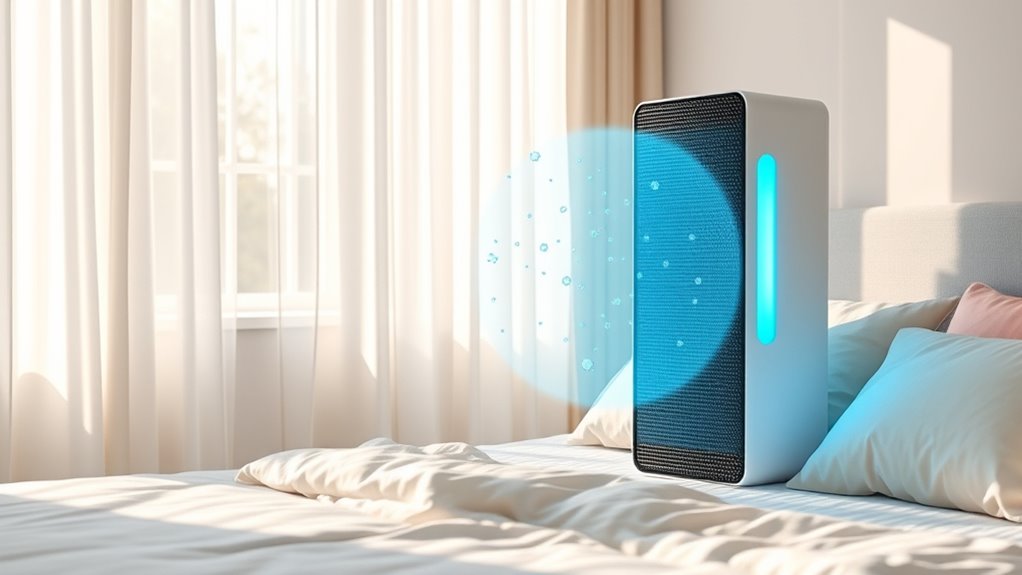
Using a high-quality air purifier with a HEPA filter can reliably reduce pollen and allergens in your home. Proper placement guarantees maximum efficiency, so position it in rooms where you spend the most time. When you choose the right purifier, you’ll notice clearer air and relief from allergy symptoms. Additionally, selecting a model with smart capabilities or multi-functionality can enhance your overall air quality management. HEPA filtration effectively captures small particles, ensuring continuous allergen removal.
Effective HEPA Filtration Benefits
High-quality air purifiers equipped with HEPA filters can substantially reduce airborne allergens, making a noticeable difference in allergy season. These filters capture up to 99.97% of particles as small as 0.3 microns, including pollen, dust mites, and pet dander. The result is a significant improvement in air quality, helping you breathe easier and reducing allergy symptoms. Effective HEPA filtration enhances allergen reduction techniques by continuously cleaning the air in your bedroom, preventing allergens from settling on surfaces or lingering in the air. Using a reliable air purifier with a true HEPA filter provides consistent, long-term benefits, especially during peak pollen times. Incorporating auto functionality can optimize air cleaning based on real-time air quality levels. This simple upgrade creates a healthier sleep environment and supports your overall allergy management plan.
Proper Air Purifier Placement
To maximize the effectiveness of your air purifier with a HEPA filter, you need to place it in the right spot. Proper air purifier placement guarantees ideal filter positioning, allowing it to capture airborne pollen and allergens efficiently. Position your purifier in the center of your bedroom or near common allergen sources, such as windows or bedding. Avoid placing it behind furniture or curtains that block airflow. Keep it at least a few feet away from walls or electronics to prevent airflow obstructions. Ensure the purifier runs continuously for best results. Using a room coverage size that matches your space ensures optimal performance. By paying attention to air purifier placement, you’ll improve airflow and allergen removal, creating a cleaner, pollen-proof environment for a better night’s sleep.
Regularly Washing Bedding and Curtains
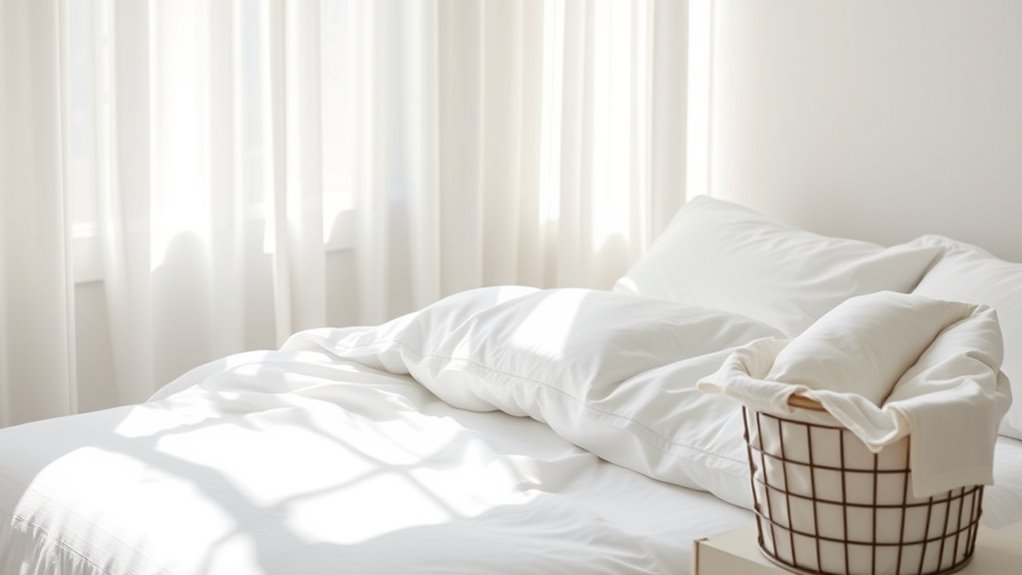
To reduce allergens, wash your bedding and curtains regularly using hot water settings. Aim for weekly washes or more often if needed, and choose hypoallergenic detergents to minimize irritation. These simple steps can make a noticeable difference in your allergy symptoms. Additionally, consider replacing old curtains with shower curtains, which are easier to clean and less likely to harbor dust mites.
Choose Hot Water Settings
Washing bedding and curtains in hot water effectively kills dust mites and removes allergens that can trigger allergy symptoms. To maximize bedding hygiene, set your washing machine to the highest safe temperature, usually around 130°F (54°C). Hot water penetrates fabrics deeply, eliminating dust mites, pollen, and pet dander that hide in fibers. Regularly using hot water ensures your bedding stays allergen-free and promotes a healthier sleep environment. Be sure to check care labels to avoid damaging delicate fabrics, and consider using a hypoallergenic detergent for added protection. Proper hot water settings are a simple yet powerful step in reducing allergen buildup, helping you breathe easier and enjoy a more comfortable, pollen-proof bedroom during allergy season. Additionally, using mattress protectors can provide an extra barrier against allergens, further enhancing your allergy relief efforts.
Wash Weekly or More
Regularly washing your bedding and curtains helps keep allergens at bay and maintains a healthier sleeping environment. Use hot water settings to eliminate pollen, dust mites, and other irritants effectively. When selecting bedding materials, opt for tightly woven fabrics that resist dust accumulation. Don’t forget to maintain your air purifier; clean or replace filters weekly to guarantee it effectively captures airborne allergens. Washing sheets, pillowcases, and curtains more frequently during pollen season reduces allergen buildup. Consider using allergen-proof covers on mattresses and pillows for extra protection. Consistent cleaning of your bedding and curtains, combined with proper air purifier maintenance, creates a cleaner, less allergenic space. This routine can considerably reduce allergy symptoms and make your bedroom a more comfortable refuge during pollen season. Proper ventilation and air filtration systems further enhance allergen control in your space.
Use Hypoallergenic Detergents
Using hypoallergenic detergents when cleaning your bedding and curtains guarantees that allergens are effectively removed without leaving behind irritants that can trigger your allergies. These specially formulated detergents ensure allergen free cleaning, helping to reduce pollen, dust mites, and other common triggers. Regularly washing your bedding and curtains with hypoallergenic products minimizes allergen buildup and creates a safer sleeping environment. Make sure to choose detergents labeled for allergen free cleaning, as they’re designed to eliminate irritants without adding chemical residues that can worsen allergy symptoms. Incorporating proper cleaning techniques into your routine can further enhance allergen removal and improve your overall comfort. By incorporating hypoallergenic detergents into your routine, you’re taking a simple but essential step toward controlling allergens in your bedroom. This proactive approach helps you breathe easier and enjoy more comfortable, allergy-free nights.
Minimizing Clutter and Dust Collectors in Your Room

Since clutter and dust tend to accumulate quickly, taking steps to reduce these in your room can make a significant difference during allergy season. Focus on clutter reduction by keeping surfaces clear and organizing items in closed storage containers. This not only minimizes dust collectors where dust mites and pollen can settle but also helps maintain a more secure environment that is easier to clean. Regularly dust and vacuum your room, paying special attention to corners, shelves, and under furniture. Using a damp cloth instead of a dry duster helps prevent dust from becoming airborne. Avoid cluttered surfaces and unnecessary decorative items that trap dust. By maintaining a tidy, clutter-free environment and practicing dust prevention, you’ll reduce allergy triggers and create a cleaner, healthier space during peak pollen season.
Installing a Pollen-Resistant Ventilation System
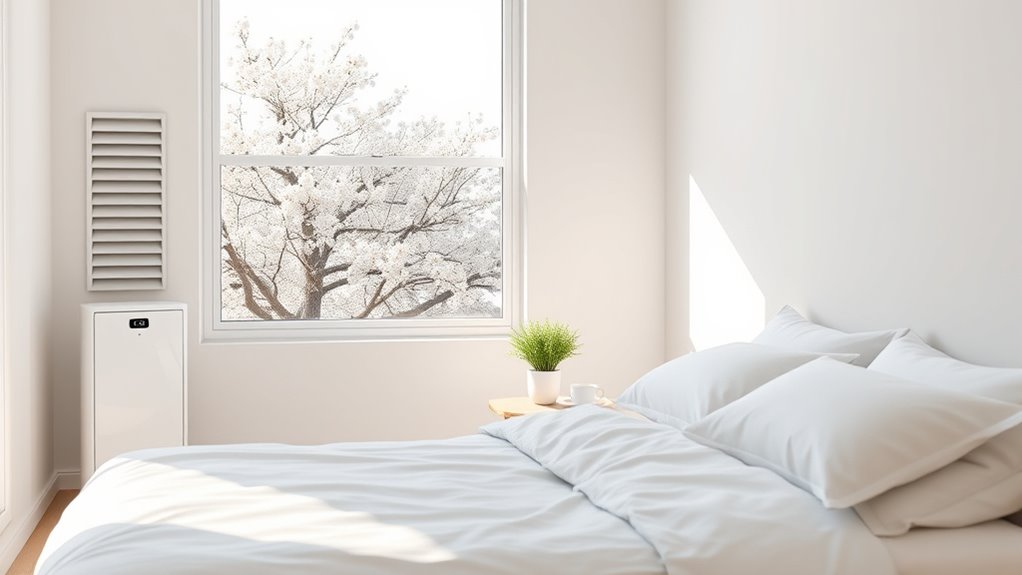
Installing a pollen-resistant ventilation system can substantially improve indoor air quality during allergy season. A proper ventilation system filters out pollen particles, preventing them from circulating inside your bedroom. Look for systems specifically designed with pollen resistance features, such as high-efficiency filters or HEPA filters, that trap airborne allergens effectively. By upgrading your ventilation system, you reduce pollen buildup and improve airflow, which helps keep your room cleaner and less allergenic. Guarantee the system is properly sealed and maintained, replacing filters regularly to maintain ideal pollen resistance. This proactive step not only reduces allergy symptoms but also creates a healthier sleeping environment. Installing a pollen-resistant ventilation system is a smart investment in your allergy season defense plan. Consider choosing a ventilation system with high-efficiency filters for optimal pollen removal.
Managing Pets and Their Access to the Bedroom
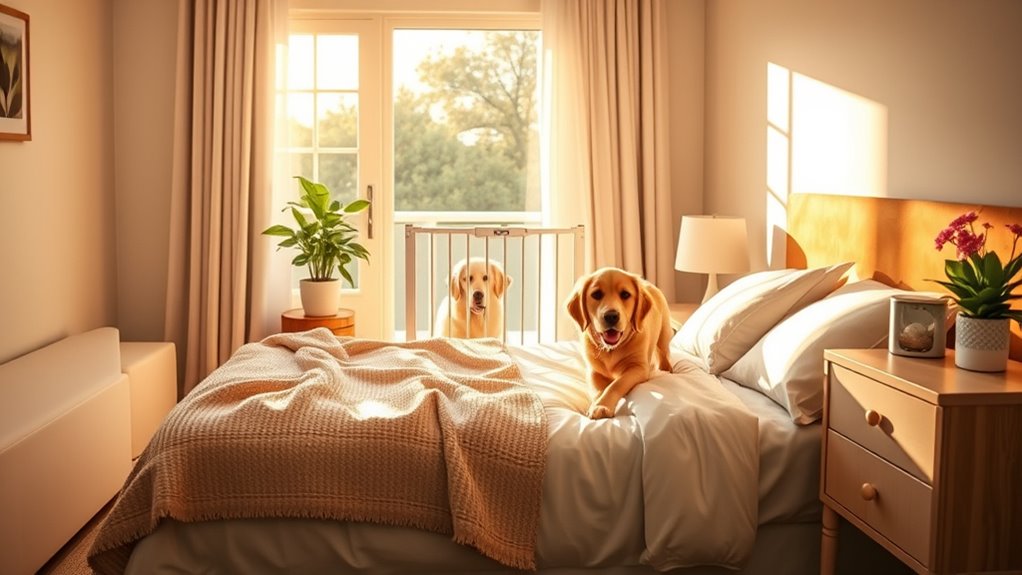
You can reduce allergens by regularly removing pet hair from your bedroom surfaces. Creating designated pet spaces helps keep fur and dander contained, making cleanup easier. Limiting your pet’s access to the bedroom minimizes allergy triggers and creates a more comfortable space for you. Using acne patches or similar barrier methods can also help protect your skin from accumulated allergens and irritants.
Pet Hair Removal Tips
To effectively manage pet hair in the bedroom, it’s essential to control your pet’s access to the space. Regular pet hair removal is key to reducing allergens and fur shedding. Brush your pets frequently using a high-quality grooming tool to catch loose fur before it spreads. Consider investing in a vacuum designed for pet hair, and vacuum your bedroom at least twice a week, focusing on carpets, rugs, and furniture. Use lint rollers or rubber gloves to quickly pick up pet hair from bedding and upholstery. Wash pet bedding regularly in hot water to eliminate trapped fur and dander. Maintaining a strict grooming routine and cleaning schedule helps keep fur shedding management in check, creating a cleaner, allergy-friendly bedroom environment. Additionally, choosing pimple patches with hydrocolloid technology can help treat skin blemishes without disrupting your skincare routine, making your bedroom a more comfortable space.
Designated Pet Spaces
Creating designated pet spaces helps keep pet hair and dander out of the bedroom. By restricting your pet’s access, you reduce exposure to pet allergies and minimize contamination of your bedding. To make this effective, set up a specific area where your pet can relax, with comfortable pet bedding that’s easy to wash. Keep the space tidy and vacuum nearby regularly to prevent hair buildup. Consider using air purifiers near the pet zone to trap dander before it spreads. If your pet has allergies, avoid letting them sleep on your bed, and instead, encourage them to rest in their designated spot. This simple step helps maintain a cleaner, allergen-reduced environment, giving you better relief during allergy season.
Incorporating Plants and Natural Air Cleaners Carefully
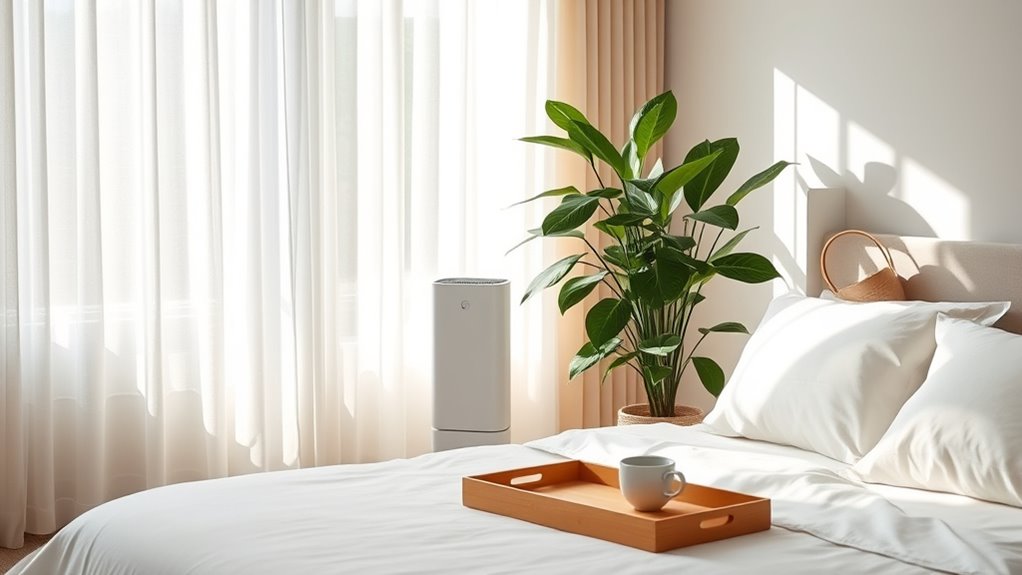
While plants and natural air purifiers can help improve indoor air quality, choosing them carefully during allergy season is vital. Focus on indoor plant selection by picking low-pollen, non-allergenic plants to minimize reactions. Natural air filter plants like snake plants or pothos are excellent options because they naturally purify the air without releasing pollen. Avoid flowering plants that produce pollen or release fragrant blooms, which can worsen allergy symptoms. Make sure your chosen plants are kept clean and dust-free, as mold and dust can also trigger allergies. Position plants away from your sleeping area to reduce exposure, and regularly check for pests or mold. By selecting the right natural air purifiers, you can enhance air quality without risking allergy flare-ups.
Keeping Shoes and Outerwear Out of the Bedroom
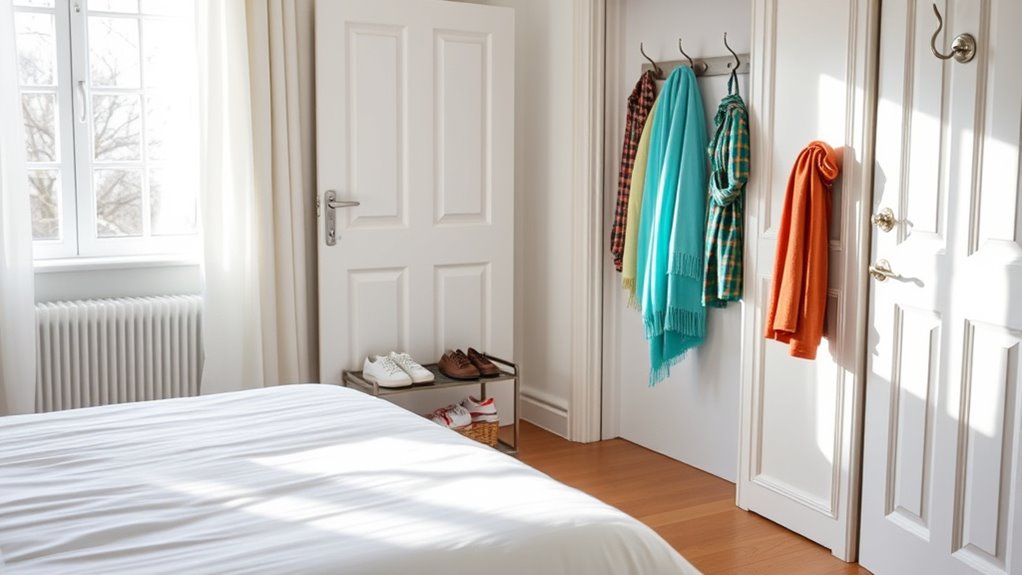
Keeping shoes and outerwear out of the bedroom is a simple yet effective step to reduce allergy triggers during the season. Proper shoe storage and outerwear management prevent pollen, dust, and other allergens from entering your sleeping space. Use a designated shoe rack or closet by the door to keep outdoor footwear contained. Keep jackets, hats, and scarves in a mudroom or entryway instead of your bedroom. This minimizes pollen transfer from outdoor gear to your bedding and surfaces. Regularly wipe down shoes and outerwear before bringing them inside. Encourage family members to adopt this habit to maintain a cleaner, allergy-friendly bedroom environment. By controlling what enters your space, you reduce the risk of pollen accumulation and improve your overall allergy relief.
Establishing a Routine for Cleaning and Maintenance

Establishing a consistent cleaning and maintenance routine is essential for managing allergy symptoms effectively. Regularly clean your bedroom surfaces to remove dust and pollen buildup. Keep up with air purifier maintenance by replacing filters as recommended, ensuring it works efficiently to trap airborne allergens. Prioritize bedding hygiene by washing sheets, pillowcases, and blankets weekly in hot water to eliminate pollen and dust mites. Vacuum carpets and upholstery frequently using a HEPA filter vacuum to reduce allergen presence. Dust surfaces with a damp cloth to prevent stirring up dust. Keep clutter to a minimum to reduce dust traps. Consistent upkeep minimizes pollen infiltration and allergen buildup, creating a healthier sleep environment and easing allergy symptoms during peak seasons.
Frequently Asked Questions
How Can I Reduce Indoor Mold That Worsens Allergy Symptoms?
To reduce indoor mold that worsens allergy symptoms, you should focus on indoor moisture control by fixing leaks and using dehumidifiers. Consider applying mold-resistant paints on walls and ceilings to prevent mold growth. Keep your bathroom and kitchen well-ventilated, and clean damp areas regularly. These steps help create an environment less hospitable to mold, easing allergy symptoms and improving indoor air quality.
Are Air Purifiers Effective Against Airborne Allergens Besides Pollen?
Did you know that air purifiers can remove up to 99% of airborne allergens? They’re highly effective against dust mites, pet dander, mold spores, and other irritants. With advanced allergen filtration technology, air purifier efficiency guarantees cleaner, healthier air in your room. By running one consistently, you reduce allergen levels and breathe easier, especially during allergy season, making your environment much more comfortable and allergy-proof.
What Are the Best Hypoallergenic Materials for Bedding?
You should choose bedding made from hypoallergenic fabrics like tightly woven cotton, silk, or microfiber. These materials resist dust mites and allergens better than traditional options. Look for allergy-proof bedding with allergen barriers or encasing, which helps prevent allergens from penetrating. By selecting the right hypoallergenic fabrics and allergy-proof bedding, you create a cleaner, healthier sleeping environment that reduces allergy symptoms and helps you breathe easier during allergy season.
How Does Humidity Level Affect Pollen and Dust Mite Presence?
Think of humidity control as a gentle gatekeeper, keeping pollen and dust mites at bay. When humidity levels stay between 30-50%, dust mite reduction becomes easier, because they thrive in damp environments. Too moist, and pollen clings like a stubborn shadow; too dry, and dust mites struggle to survive. Maintaining ideal humidity creates a hostile environment for these allergens, helping you breathe easier and sleep more soundly.
Can Certain Cleaning Products Worsen Allergy Symptoms Indoors?
Certain cleaning product ingredients can worsen allergy symptoms indoors. Many contain fragrances, dyes, or harsh chemicals that trigger allergic reactions in sensitive individuals. To minimize this, choose fragrance-free, hypoallergenic cleaners with gentle ingredients. Always read labels carefully and avoid products with known irritants. Ventilate your space during and after cleaning to reduce airborne particles. By selecting safer options, you can help prevent allergy flare-ups and create a healthier, more comfortable environment.
Conclusion
By taking these simple steps, you can markedly reduce pollen in your bedroom and breathe easier during allergy season. Did you know that indoor air can be up to five times more polluted than outdoor air? By keeping windows closed, washing bedding regularly, and using HEPA filters, you create a healthier space. Stay consistent with your routine, and you’ll notice fewer allergy symptoms, making springtime much more comfortable for you.



